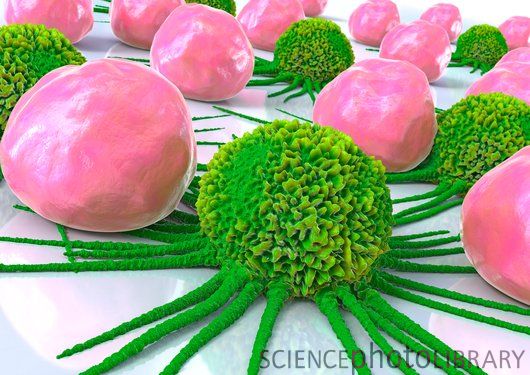 来自中科院上海生科院营养所的谢东研究组与生化与细胞所赵允研究组合作,发表了题为“RACK1 Promotes Non-small-cell Lung Cancer Tumorigenicity through Activating Sonic Hedgehog Signaling Pathway”的文章,揭示了接头蛋白RACK1(Receptor of Activated Kinase1)在非小细胞肺癌中促进肿瘤发生发展的生物学功能以及Sonic Hedgehog信号通路在非小细胞肺癌中作用的新机制。相关成果公布在Journal of Biological Chemistry杂志上。
来自中科院上海生科院营养所的谢东研究组与生化与细胞所赵允研究组合作,发表了题为“RACK1 Promotes Non-small-cell Lung Cancer Tumorigenicity through Activating Sonic Hedgehog Signaling Pathway”的文章,揭示了接头蛋白RACK1(Receptor of Activated Kinase1)在非小细胞肺癌中促进肿瘤发生发展的生物学功能以及Sonic Hedgehog信号通路在非小细胞肺癌中作用的新机制。相关成果公布在Journal of Biological Chemistry杂志上。
肺癌是严重危害人类健康的恶性肿瘤之一,也是全世界目前发病率和死亡率最高的癌症之一。非小细胞肺癌是肺癌的主要类型,五年生存率仅为15%。因此,研究肺癌的意义十分重大。
谢东研究员指导的博士生石硕等人发现在绝大多数的非小细胞肺癌中RACK1的表达显著升高,并且它的表达水平与肿瘤的临床和病理参数如肿瘤的分化、分级和转移有显著的相关性。在非小细胞肺癌中RACK1通过与Sonic hedgehog信号通路中的Smoothened结合,活化Smoothened,从而激活Gli1的转录,促进Sonic hedgehog 信号通路的激活。沉默RACK1可抑制Sonic hedgehog信号通路进而抑制非小细胞肺癌细胞生长和迁移以及体内肿瘤的生长和转移。这些实验结果表明RACK1有可能成为一个潜在的非小细胞肺癌治疗靶点。
之前谢东研究组还发现了Eph家族成员:EphB3在非小细胞肺癌临床样本和肿瘤细胞株中都呈现高表达的趋势,并且其表达水平和临床病理参数密切相关,包括肿瘤大小,分化程度以及转移。
在非小细胞肺癌细胞系H520中过表达EphB3能够促进细胞的生长和迁移,并且显著增强细胞在裸鼠体内的成瘤能力,而由 RNA干扰介导的对EphB3的沉默则显著抑制了肿瘤细胞的生长,迁移以及在体内的成瘤和转移能力。研究人员发现干扰EphB3引起的生长抑制是由于DNA 合成降低和caspase-8介导的凋亡途径所共同作用的结果。另一方面,干扰EphB3 引起 FAK(pY397)和Paxillin(pY118)水平的上升、粘着斑(Focal adhesion)数目的增加以及周转速度的减慢,导致细胞迁移能力的下降。总之,这些工作揭示了EphB3作为非小细胞肺癌中的一个生存因子, 通过刺激细胞的增殖和迁移以及提高细胞的存活能力,促进了肿瘤的生长和转移,为非小细胞肺癌的治疗提供了潜在的药物靶点。
这些研究都表明RACK1和EphB3都有可能成为一个潜在的非小细胞肺癌治疗靶点,用于未来更准确的治疗非小细胞肺癌。

 RACK1 promotes non-small-cell lung cancer tumorigenicity through activating sonic hedgehog signaling pathway
RACK1 promotes non-small-cell lung cancer tumorigenicity through activating sonic hedgehog signaling pathway
Shuo Shi, Yue-Zhen Deng, Jiang-Sha Zhao, Xiao-Dan Ji, Jun Shi, Yun Zhao and Dong Xie
Non-small-cell lung cancer (NSCLC) is a deadly disease due to lack of effective diagnosis biomarker and therapeutic target. Much effort has been made in defining gene defects in NSCLC, but its full molecular pathogenesis remains unexplored. Here, we found RACK1 (Receptor of Activated Kinase 1) was elevated in most NSCLC, and its expression level correlated with key pathological characteristics including tumor differentiation, stage and metastasis. In addition, RACK1 activated sonic hedgehog signaling pathway by interacting with and activating Smoothened to mediate Gli1-dependent transcription in NSCLC cells. And silencing RACK1 dramatically inhibited in vivo tumor growth and metastasis by blocking the sonic hedgehog signaling pathway. These results suggest that RACK1 represents a new promising diagnosis biomarker and therapeutic target for NSCLC.
文献链接:https://www.jbc.org/content/early/2012/01/19/jbc.M111.315416







